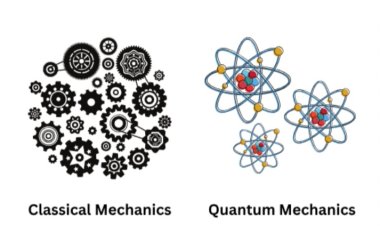Physics is the study of the fundamental laws that govern the universe, and two of the most important branches of physics are quantum mechanics and classical mechanics. While both seek to explain the behavior of physical systems, they do so in vastly different ways. In this blog, we explore the key differences between these two theories and how they shape our understanding of the world around us.

Classical Mechanics: The Foundation of Modern Physics
Classical mechanics, formulated by Isaac Newton in the 17th century, describes the motion of macroscopic objects, such as planets, cars, and baseballs. At its core, classical mechanics is based on the concept of determinism, which states that if you know the initial conditions of a system, you can predict its future behavior with certainty. This deterministic view of the universe held sway for centuries and formed the foundation of modern physics.
The Quantum Revolution: The Birth of Quantum Mechanics
In the early 20th century, physicists made a startling discovery: the laws that govern the microscopic world of atoms and subatomic particles are fundamentally different from those that govern the macroscopic world. This led to the development of quantum mechanics, a new theory that describes the behavior of particles at the smallest scales. Unlike classical mechanics, quantum mechanics is probabilistic, meaning that it can only predict the likelihood of a particle being in a certain state, rather than its exact position or velocity.
Key Differences Between Quantum and Classical Mechanics:
1. **Wave-Particle Duality**:
In quantum mechanics, particles such as electrons exhibit both wave-like and particle-like behavior, a phenomenon known as wave-particle duality. This is in stark contrast to classical mechanics, where particles are strictly considered as point-like objects with definite positions and velocities.
2. **Uncertainty Principle**:
Quantum mechanics introduces the uncertainty principle, which states that it is impossible to simultaneously know both the exact position and momentum of a particle. This principle has no analog in classical mechanics, where the position and momentum of a particle can be precisely determined.
3. **Quantization**:
Quantum mechanics introduces the concept of quantization, which states that certain properties of particles, such as energy levels, can only take on discrete values. In classical mechanics, these properties are continuous and can take on any value.
Implications and Applications:
The differences between quantum and classical mechanics have profound implications for our understanding of the universe and have led to the development of technologies such as quantum computing, which harnesses the principles of quantum mechanics to perform calculations at speeds far beyond what is possible with classical computers. Quantum mechanics has also revolutionized fields such as chemistry and materials science, providing new insights into the behavior of atoms and molecules.
Conclusion:
Quantum mechanics and classical mechanics represent two distinct but complementary views of the physical world. While classical mechanics provides a reliable framework for understanding the motion of everyday objects, quantum mechanics is essential for understanding the behavior of particles at the smallest scales. Together, these two theories form the foundation of modern physics, shaping our understanding of the universe from the smallest particles to the largest galaxies.
